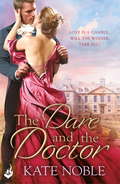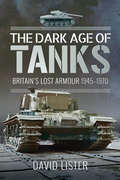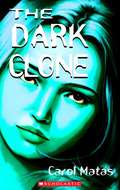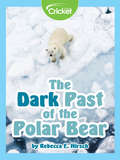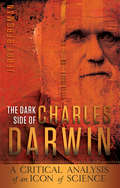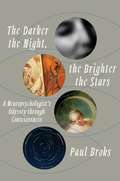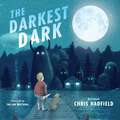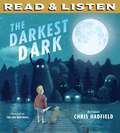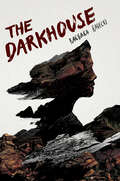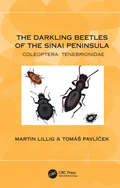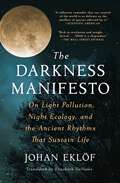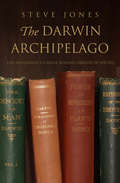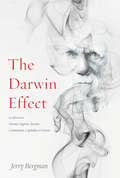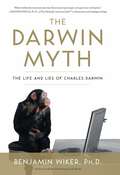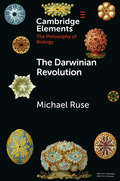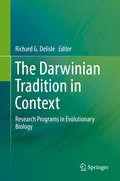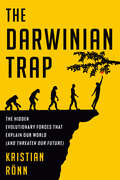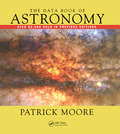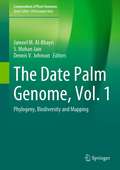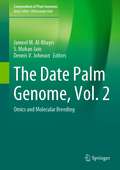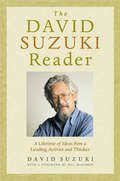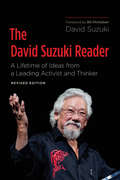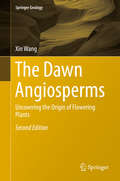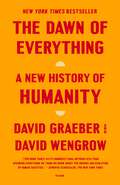- Table View
- List View
The Dare and the Doctor: Winner Takes All 3 (Winner Takes All)
by Kate NobleFrom Kate Noble, part of the sensational writing team behind The Lizzie Bennet Diaries, comes the third novel in a dazzling and superbly witty historical romance series that's part Trading Places, part Pride and Prejudice. Perfect for fans of Julia Quinn, Stephanie Laurens and Tessa Dare.The best of friends might be the perfect match . . . What's the worst that can happen?Margaret Babcock had always been content with her quiet life in the country. But with her late mother's words 'What's the worst that could happen?' ringing in her ears, she longs to spread her wings. So when her long-time correspondent Dr Rhys Gray invites her to London, she eagerly accepts.Many happy hours are spent touring the wonders of the city - purely as friends, of course. But would friends miss each other so fiercely when they're apart? Or feel such a spark together? And matters are complicated even further when it transpires that Rhys may be promised to another. Will their 'friendship' survive?Be dazzled by Kate Noble's previous Winner Takes All books: The Game and the Governess and The Lie and the Lady.
The Dark Age of Tanks: Britain's Lost Armour, 1945–1970
by David ListerA British tank historian sheds new light on the UK’s Cold War era research and development of cutting-edge military vehicles and anti-tank weaponry.In the thirty years after the Second World War, the British army entered a period of intense technological development. Yet, due to the lack of surviving documentation, comparatively little is known about this period. What does survive, however, reveals the British Army’s struggle to use cutting edge technology to create weapons that could crush the Soviet Union's armed forces, all the while fighting against the demands of Her Majesty's Treasury.On this journey, the Army entertained ideas such as massive 183mm anti-tank guns, devastating rocket artillery, colossal anti-tank guided missiles, and micro-tanks operable by crews of only two. At one point, they were on the cusp of building hover tanks. This book explores a time period of increasing importance in military engineering history and brings much-needed light to the dark age of British tanks.
The Dark Clone (Cloning Miranda #3)
by Carol MatasThe thrilling sequel to Cloning Miranda and The Second Clone. When Miranda is accused of vandalism on school property, she's confident she can clear her name - until she's shown the security tapes.
The Dark Past of the Polar Bear
by Rebecca E. HirschPolar bears rule the frozen sea, but their ancestors weren't always built for ice and snow.
The Dark Side of Charles Darwin: A Critical Analysis of an Icon of Science
by Dr Jerry BergmanA single man stands behind the greatest deception in history. Charles Darwin's ideas still penetrate every aspect of our culture, including science, religion, and education. And while much has been made of his contribution to the evolutionary hypothesis, little has been publicized about the dark side of the man himself and how this may have impacted the quality and legitimacy of his research. This daring and compelling book takes its readers behind the popular facade of a man revered worldwide as a scientific pioneer, and unveils what kind of person Darwin really was. The book reveals disturbing facts that will help you: Perceive Darwin firsthand through the eyes of family and friends, and his own correspondence Discern this darkly troubled man, struggling with physical and mental health issues Uncover his views on eugenics and racism, and his belief that women were less evolved than men Thoroughly documented, this book reveals Darwin's less-than-above board methods of attempting to prove his so-called scientific beliefs, and his plot to "murder God" by challenging the then-dominant biblical worldview.
The Darker the Night, the Brighter the Stars: A Neuropsychologist's Odyssey Through Consciousness
by Paul BroksWhen celebrated neuropsychologist Paul Broks's wife died of cancer, it sparked a journey of grief and reflection that traced a lifelong attempt to understand how the brain gives rise to the soul. The result of that journey is a gorgeous, evocative meditation on fate, death, consciousness, and what it means to be human. The Darker the Night, The Brighter the Stars weaves a scientist’s understanding of the mind – its logic, its nuance, how we think about what makes a person – with a poet’s approach to humanity, that crucial and ever-elusive why. It’s a story that unfolds through the centuries, along the path of humankind’s constant quest to discover what makes us human, and the answers that consistently slip out of our grasp. It’s modern medicine and psychology and ancient tales; history and myth combined; fiction and the stranger truth. But, most importantly, it’s Broks’ story, grounded in his own most fascinating cases as a clinician—patients with brain injuries that revealed something fundamental about the link between the raw stuff of our bodies and brains and the ineffable selves we take for who we are. Tracing a loose arc of loss, acceptance, and renewal, he unfolds striking, imaginative stories of everything from Schopenhauer to the Greek philosophers to jazz guitarist Pat Martino in order to sketch a multifaceted view of humanness that is as heartbreaking at it is affirming.
The Darkest Dark
by Chris Hadfield Kate FillionInspired by the childhood of real-life astronaut Chris Hadfield and brought to life by Terry and Eric Fan's lush, evocative illustrations, The Darkest Dark will encourage readers to dream the impossible. Chris loves rockets and planets and pretending he's a brave astronaut, exploring the universe. Only one problem--at night, Chris doesn't feel so brave. He's afraid of the dark. But when he watches the groundbreaking moon landing on TV, he realizes that space is the darkest dark there is--and the dark is beautiful and exciting, especially when you have big dreams to keep you company.
The Darkest Dark: Read & Listen Edition
by Chris Hadfield Kate FillionInspired by the childhood of real-life astronaut Chris Hadfield and brought to life by Terry and Eric Fan's lush, evocative illustrations, The Darkest Dark will encourage readers to dream the impossible. Chris loves rockets and planets and pretending he's a brave astronaut, exploring the universe. Only one problem--at night, Chris doesn't feel so brave. He's afraid of the dark. But when he watches the groundbreaking moon landing on TV, he realizes that space is the darkest dark there is--and the dark is beautiful and exciting, especially when you have big dreams to keep you company.
The Darkhouse
by Barbara RadeckiFifteen-year-old Gemma’s life on a small New Brunswick island with her father, Jonah, is not an exciting one. Her mother ran off when she was an infant, and Jonah, an amateur scientist, spends most of his time conducting experiments he thinks will one day bring him fame. But when a woman arrives on the island, Gemma tries to play matchmaker – only to discover Jonah’s hidden journals, which hold terrifying secrets about both their lives. Mystery, science, and dreams of a better life collide in this page-turning young adult novel from Barbara Radecki.
The Darkling Beetles of the Sinai Peninsula: Coleoptera: Tenebrionidae
by Martin Lillig Tomáš PavlíčekAn expanded and updated edition of the out-of-print 2003 supplementum of Zoology in the Middle East, this concise guide to Darkling Beetles of the Sinai Peninsula has been sought after by researchers in taxonomy, faunistics and biogeography. The new book includes two additional subfamilies of tenebrionid beetles (4-5 species), identification keys and more than 90 colour photographs and species distribution maps. Zoogeographically speaking, the Sinai Peninsula is a crossroad and, at the same time, a center of speciation. Despite its generally arid character, the region harbours a wide range of habitats, from sea level to over 2,500 m above. About 10 percent of the Sinai darkling beetles are endemic to the area. The inclusion of species photographs and identification keys makes this book an invaluable reference field guide, for both specialists and non-specialists, who will thus be able to discover the taxonomic and phylogenetic diversity of darkling beetles in the Sinai Peninsula.
The Darkness Manifesto: On Light Pollution, Night Ecology, and the Ancient Rhythms that Sustain Life
by Johan EklöfIn the bestselling tradition of Why We Sleep and The Sixth Extinction, an urgent and insightful look at the hidden impact of light pollution, and a passionate appeal to cherish natural darkness for the sake of the environment, our own well-being, and all life on earth.How much light is too much light? Satellite pictures show our planet as a brightly glowing orb, and in our era of constant illumination, light pollution has become a major issue. The world&’s flora and fauna have evolved to operate in the natural cycle of day and night. But in the last 150 years, we have extended our day—and in doing so have forced out the inhabitants of the night and disrupted the circadian rhythms necessary to sustain all living things, including ourselves. In this persuasive, well-researched book, Swedish conservationist Johan Eklöf urges us to appreciate natural darkness, its creatures, and its unique benefits. Eklöf ponders the beauties of the night sky, traces the errant paths of light-drunk moths and the swift dives of keen-eyed owls, and shows us the bioluminescent creatures of the deepest oceans. As a devoted friend of the night, he writes passionately about the startling damage we inflict on ourselves and our fellow creatures simply by keeping the lights on. The Darkness Manifesto depicts the domino effect of diminishing darkness: insects, dumbfounded by streetlamps, failing to reproduce; birds blinded and bewildered by artificial lights; and bats starving as they wait in vain for food insects that only come out in the dark of night. For humans, light-induced sleep disturbances impact our hormones and weight, and can contribute to mental health problems like chronic stress and depression. The streetlamps, floodlights, and neon signs of cities are altering entire ecosystems, and scientists are only just beginning to understand the long-term effects. The light bulb—long the symbol of progress and development—needs to be turned off. Educational, eye-opening, and ultimately encouraging, The Darkness Manifesto outlines simple steps that we can take to benefit ourselves and the planet. In order to ensure a bright future, we must embrace the darkness.
The Darwin Archipelago
by Steve JonesCharles Darwin is of course best known for The Voyage of the Beagle and The Origin of Species. But he produced many other books over his long career, exploring specific aspects of the theory of evolution by natural selection in greater depth. The eminent evolutionary biologist Steve Jones uses these lesser-known works as springboards to examine how their essential ideas have generated whole fields of modern biology. Earthwormshelped found modern soil science,Expression of the Emotionshelped found comparative psychology, andSelf-FertilizationandForms of Flowerswere important early works on the origin of sex. Through this delightful introduction to Darwin's oeuvre, one begins to see Darwin's role in biology as resembling Einstein's in physics: he didn't have one brilliant idea but many and in fact made some seminal contribution to practically every field of evolutionary study. Though these lesser-known works may seem disconnected, Jones points out that they all share a common theme: the power of small means over time to produce gigantic ends. Called a "world of wonders" by theTimesof London,The Darwin Archipelagowill expand any reader's view of Darwin's genius and will demonstrate how all of biology, like life itself, descends from a common ancestor.
The Darwin Effect
by Dr Jerry BergmanDr. Miklos Nyiszli, an imprisoned doctor in the Auschwitz camp, wrote that Nazi doctors hoped studying twins would solve the problem of faster reproduction of superior races. Nazis hoped to have each German mother bear as many twins as possible.What Darwin influenced went far beyond the Nazi death camps: Shocking political, social, and scientific legacies of Darwin and his family Disturbing disclosure of how over 45 million Christians were killed in the 20th century because of their faith Revealing and layman-friendly presentation. This book is the result of 30 years of research and study carefully documenting the common destructive threads that tie some of history's most murderous dictators, uncaring capitalists, and aggressive social activists to the flawed concepts of Charles Darwin in an effort to change the world -- and how they succeeded. The extermination of races considered "lower" than others, the profound lack of empathy for less-advanced cultures, the corrupted atheistic justifications for taking the lives of millions -- all done to advance the agendas of social Darwinism at work in the world today. More than mere theoretical discussions, we have seen the horrifying evidence of the practical results when applying these destructive and misleading concepts to society in the last 100 years!
The Darwin Myth: The Life and Lies Charles Darwin
by Benjamin WikerIn The Darwin Myth, author Benjamin Wiker offers a critical analysis of Darwin's theories as well as the social, scientific, and religious implications of his work, leading us to the inevitable truth about Darwin's powerful - yet ultimately poisonous - legacy. Scientists often challenge conventional wisdom and spark debates that last for generations. But no scientist has fuelled more debate than Charles Darwin.To some he is the revolutionary 'father' of evolution. To others he is the perverse 'originator' of modern eugenics. And in The Darwin Myth: The Life and Lies of Charles Darwin, author Benjamin Wiker brings these conflicting identities to light. He offers a critical examination of Darwin's theories as well as the scientific, social, and religious implications of his life and work. In The Darwin Myth, Wiker reveals: How Darwin's theories were originally met by scepticism and criticism - much of which he couldn't refute and are still valid today; why Darwin didn't 'discover' evolution; and how science itself suggests God created the universe. Laying out the evidence and sound scientific arguments, Wiker illuminates the inevitable truth about Darwin's powerful - yet ultimately poisonous - legacy.
The Darwinian Revolution (Elements in the Philosophy of Biology)
by Michael RuseWhat is the Darwinian revolution and why is it important for philosophers? These are the questions tackled in this Element. In four sections, the topics covered are the story of the revolution, the question of whether it really was a revolution, the nature of the revolution, and the implications for philosophy, both epistemology and ethics.
The Darwinian Tradition in Context: Research Programs In Evolutionary Biology
by Richard G. DelisleIt is the main goal of this volume to put in context the Darwinian tradition by raising questions such as: How should it be defined? Did it interacted with other research programs? Where there any research programs whose developments were largely conducted independently of the Darwinian tradition? Contributors to this volume explicitly reflect upon the nature of the relationship between the Darwinian tradition and other research programs running in parallel. In the wake of the Synthetic Theory of Evolution which was constituted in the 1930s, 1940s, and 1950s, historians and philosophers of biology have devoted considerable attention to the Darwinian tradition, i. e. , linking Charles Darwin to mid-Twentieth-Century developments in evolutionary biology. Since then, more recent developments in evolutionary biology challenged, in part only or entirely, the heritage of the Darwinian tradition. Expectedly, this was followed by a historiographical "recalibration" by historians and philosophers towards other research programs and traditions part of evolutionary biology since Darwin's time. In order to acknowledge this shift, papers have been arranged along two main threads: Part I: The view that sees Darwinism as either originally pluralistic or acquiring such a pluralism through modifications and borrowings over time. Part II: The view blurring the boundaries between non-darwinian and darwinian traditions, either by holding that Darwinism itself was never quite as darwinian as previously thought, or that non-darwinian traditions took on board some darwinian components, when not fertilizing Darwinism directly. Between a Darwinism reaching out to other research programs and non-darwinian programs reaching out to Darwinism, the least that can be said is that this criss-crossing of intellectual threads blurs the historiographical field. This volume aims to open new thinking avenues about the development of evolutionary biology.
The Darwinian Trap: The Hidden Evolutionary Forces That Explain Our World (and Threaten Our Future)
by Kristian RönnA provocative exploration of how humans are wired to seek short-term success at the expense of long-term survival—an evolutionary &“glitch&” that explains everything from toxic workplaces to climate change&“Essential reading . . . a lively, ultimately hopeful examination of how incentivizing the wrong values and actions has led to some of our most intractable problems.&”—Eric Ries, New York Times bestselling author of The Lean StartupWhen people talk about today&’s biggest challenges—pollution, misinformation, artificial intelligence, inept CEOs, and politicians—they tend to frame the conversation around &“bad people&” doing &“bad things.&” But is there more to the story?Humans, it turns out, are intrinsically wired to seek short-term success at the expense of long-term prosperity. Kristian Rönn, an entrepreneur formerly affiliated with the University of Oxford&’s Future of Humanity Institute, calls these deeply rooted impulses &“Darwinian demons.&” These forces, a by-product of natural selection, can lead us to act in shortsighted ways that harm others—and even imperil our survival as a species. If this evolutionary glitch is left unchecked, the consequences will grow in magnitude as the power of technology accelerates.In this eye-opening work, Rönn shows that we must learn to cooperate in new ways if we are to escape these evolutionary traps in our daily lives and solve our biggest existential threats. Evolution may be to blame for the trap—but humans need not fall for it. Our salvation, he writes, will involve the creation of new systems that understand, track, and manage what humankind values most.Bold, brilliant, and ultimately optimistic, The Darwinian Trap gives readers a powerful new lens on our world and its problems, and invites us to rethink our priorities for the sake of generations to come.
The Data Book of Astronomy
by Patrick MooreFilled with data about the Earth, Moon, the planets, the stars, our Galaxy, and the myriad galaxies in deep space, this invaluable resource reveals the latest scientific discoveries about black holes, quasars, and the origins of the Universe. It includes maps supported by detailed tables of the names, positions, magnitudes, and spectra of the main stars in each constellation along with key data on galaxies, nebulae, and clusters. MNASSA wrote, "This book fills a niche � with detailed astronomical data and concise explanations, all at an accessible level � it is an excellent resource, and probably will be the first book I shall reach for.
The Date Palm Genome, Vol. 1: Phylogeny, Biodiversity and Mapping (Compendium of Plant Genomes)
by S. Mohan Jain Jameel M. Al-Khayri Dennis V. JohnsonThis book is the first volume of a comprehensive assemblage of contemporary knowledge relevant to genomics and other omics in date palm. Volume 1 consists of 11 chapters arranged in 3 parts grouped according to subject. Part I, Biology and Phylogeny, focuses on date palm biology, evolution and origin. Part II, Biodiversity and Molecular Identification, covers conformity of in vitro derived plants, molecular markers, barcoding, pollinizer genetics and gender determination. Part III, Genome Mapping and Bioinformatics, addresses genome mapping of nuclear, chloroplast and mitochondrial DNA, in addition to a chapter on progress made in date palm bioinformatics. This volume represents the efforts of 30 international scientists from 10 countries and contains 78 figures and 30 tables to illustrate presented concepts. Volume 2 is published under the title: Omics and Molecular Breeding.
The Date Palm Genome, Vol. 2: Omics and Molecular Breeding (Compendium of Plant Genomes)
by S. Mohan Jain Jameel M. Al-Khayri Dennis V. JohnsonThis book is the first comprehensive assemblage of contemporary knowledge relevant to genomics and other omics in date palm. Volume 2 consists of 11 chapters. Part I, Nutritional and Pharmaceuticals Properties, covers the utilization of date palm as an ingredient of various food products, a source of bioactive compounds and the production of nanomaterials. Part II, Omics Technologies, addresses omics resources, proteomics and metabolomics. Part III, Molecular Breeding and Genome Modification, focuses on genetic improvement technologies based on mutagenesis, quantitative traits loci and genome editing. Part IV, Genomics of Abiotic and Biotic Stress, covers metagenomics of beneficial microbes to enhance tolerance to abiotic stress and the various genomics advances as they apply to insect control. This volume represents the efforts of 34 international scientists from 12 countries and contains 65 figures and 19 tables to illustrate presented concepts. Volume 1 is published under the title: Phylogeny, Biodiversity and Mapping.
The David Suzuki Reader
by Bill Mckibben David SuzukiDavid Suzuki's collected writings on science, nature, technology, economics, politics, and the connectedness of all things.The David Suzuki Reader brings together for the first time the scientific and philosophical thought of North America's leading environmentalist.Drawing from Suzuki's published and unpublished writings, this collection reveals the underlying themes that have informed his work for over four decades. In these incisive and provocative essays, Suzuki explores the limits of knowledge and the connectedness of all things; looks unflinchingly at the destructive forces of globalization, political shortsightedness, and greed; cautions against blind faith in science, technology, politics, and economics; and provides inspiring examples of how and where to make those changes that will matter to all of us and to future generations. He also offers a vision of hope based on our love of children and nature.In this time of global unrest and uncertainty, Suzuki provides an important reminder of how we are all connected and of what really matters. Written with clarity, passion, and wisdom, this book is essential reading for anyone who is an admirer of David Suzuki, who wants to understand what science can and can't do, or who wants to make a difference.
The David Suzuki Reader
by Bill Mckibben David SuzukiIn this revised and expanded edition of his collected writings, David Suzuki continues to explore the themes that have informed his work for more than four decades - the interconnectedness of all things, our misguided elevation of economics above all else, the urgent need to deal with climate change - but with an increased emphasis on solutions to the myriad problems we face, his inspiring vision for the future, and the legacy he hopes to leave behind. There is also more emphasis on the personal, as he recounts episodes from his childhood and early adulthood and speaks eloquently about old age, death, and the abiding role of nature and family in his life. Written with clarity, passion, and wisdom, this book is essential for anyone who is an admirer of David Suzuki, who wants to understand what science can and can't do, or who wants to make a difference.
The David Suzuki Reader
by David SuzukiDavid Suzuki’s collected writings on science, nature, technology, economics, politics, and the connectedness of all things. The David Suzuki Reader brings together for the first time the scientific and philosophical thought of North America’s leading environmentalist. Drawing from Suzuki’s published and unpublished writings, this collection reveals the underlying themes that have informed his work for over four decades. In these incisive and provocative essays, Suzuki explores the limits of knowledge and the connectedness of all things; looks unflinchingly at the destructive forces of globalization, political shortsightedness, and greed; cautions against blind faith in science, technology, politics, and economics; and provides inspiring examples of how and where to make those changes that will matter to all of us and to future generations. He also offers a vision of hope based on our love of children and nature. In this time of global unrest and uncertainty, Suzuki provides an important reminder of how we are all connected and of what really matters. Written with clarity, passion, and wisdom, this book is essential reading for anyone who is an admirer of David Suzuki, who wants to understand what science can and can’t do, or who wants to make a difference.
The Dawn Angiosperms
by Xin WangAngiosperms are the most diversi ed plant group in the world, being represented by ca 300,000 species in about 400 families. Like all of Life, including ourselves, they have had their own history and gone through many evolutionary stages before they arrived at their current forms. The origin of Angiospermae ( owering plants) has been the subject of much dispute because this is a key event in the history of life, and has a far-reaching in uence on our understanding of relationships among seed plants as a whole as well as within the angiosperms. Until recently most of palae- otanists recognized angiosperms only from the Cretaceous and younger strata. This contradicts the results of molecular analyses. I have been working on Mesozoic fossil plants for the past two decades, during which time I have studied a number of fossil plants. Some of these fossil plants have been published as Jurassic angiosperms, and, unsurprisingly, many questions and doubts have been raised about them. These questions need to be addressed se- ously and journal papers do not provide suf cient space to compare and relate these early angiosperms. In this book these pioneer angiosperms are documented in detail, sometimes with new specimens not studied before. Also, I propose a de nition of angiosperms that could be adopted in palaeobotany. My aim is to improve clarity and objectivity of judgment about what constitutes a fossil angiosperm.
The Dawn of Everything: A New History of Humanity
by David Graeber David WengrowRenowned activist and public intellectual David Graeber teams up with professor of comparative archaeology David Wengrow to deliver a trailblazing account of human history, challenging our most fundamental assumptions about social evolution--from the development of agriculture and cities to the emergence of "the state," political violence, and social inequality--and revealing new possibilities for human emancipation. <p><p>For generations, our remote ancestors have been cast as primitive and childlike--either free and equal innocents, or thuggish and warlike. Civilization, we are told, could only be achieved by sacrificing those original freedoms, or alternatively, by taming our baser instincts. Graeber and Wengrow show how such theories first emerged in the eighteenth century as a conservative reaction to powerful critiques of European society posed by Indigenous observers and intellectuals. Revisiting this encounter has startling implications for how we make sense of human history today, including the origins of farming, property, cities, democracy, slavery, and civilization itself. <p><p> Drawing on path-breaking research in archaeology and anthropology, the authors show how history becomes a far more interesting place once we learn to throw off our conceptual shackles and perceive what's really there. If humans did not spend 95% of their evolutionary past in tiny bands of hunter-gatherers, what were they doing all that time? If agriculture, and cities, did not mean a plunge into hierarchy and domination, then what kinds of social and economic organization did they lead to? What was really happening during the periods that we usually describe as the emergence of "the state"? The answers are often unexpected, and suggest that the course of human history may be less set in stone, and more full of playful, hopeful possibilities, than we tend to assume. <p><p> The Dawn of Everything fundamentally transforms our understanding of the human past and offers a path toward imagining new forms of freedom, new ways of organizing society. This is a monumental book of formidable intellectual range, animated by curiosity, moral vision, and a faith in the power of direct action. <p> <b>New York Times Bestseller</b>
